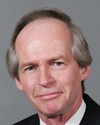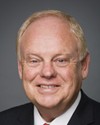Good afternoon. Thank you.
Mr. Chairman, members of the committee, it's a real pleasure to speak with you today on the topic of reclamation of site closure for oil sands mines.
My perspective is that of a land reclamation practitioner. As the manager, land and environment, at Syncrude, I work with a team of technical specialists who are actively rebuilding the landscape at Syncrude's oil sands mining operations. This year to date, our team has completed shaping and placement of the final reclamation material cover on something over 300 hectares of land--that's a little over one square mile--and has planted over half a million tree and shrub seedlings. Equally important, we've invested over $1.5 million in reclamation research.
From that perspective of active field execution of progressive reclamation, I will comment on some of our key challenges and on where our reclamation program is headed. I'm hoping these comments will be helpful to the committee in its deliberations.
The very first comment I must make—the third page in the handout—is to recognize the obvious, that oil sand mining disturbs the land, that it requires clearing of the previous existing boreal forest, stripping off of the overburden, which is that layer of material that overlies the oil sand, and then excavating the oil sands for processing. Given recognition that we do disturb the land, my industry works to minimize the footprint of our operations and to minimize the area affected at each point in time, which we accomplish through progressive reclamation. However, having disturbed the land, we have indeed assumed clear legal obligations and, I may say, equally clear social obligations to reclaim the land to acceptable standards.
On page 5 of the handout, I have included the Alberta law that applies the concept of capability and requires post-closure landscape to have equivalent capability to pre-disturbance landscape. We also, of course, must satisfy other provincial statutes and federal statutes, the most prominent of which would be the Fisheries Act, provisions around fish habitat and the health of fisheries.
Page 6 of the handout is our closure vision. To help us focus on our challenge, as land reclamation practitioners we have crafted a vision for the post-closure landscape for the landscape we will leave behind for the people who will be living in the Wood Buffalo region after we're finished our work and gone. We recognize that there will be people, particularly aboriginal communities, who will be looking for that landscape to continue to support their existence in the region. In our vision, we speak of a mosaic of landscape elements yielding a landscape that will be useful, a landscape that will be robust and resilient enough to mature into harmony with the surrounding boreal forest.
Page 7 is a pictorial display of that vision. But perhaps most important, page 8 of the handout is a block of reclaimed land that we can point to and say that this is our vision. It's almost a shame the committee was visiting Fort McMurray in a winter season; we love to show the reclaimed land when it's green and thriving.
The photograph on page 8 shows a portion of the Syncrude Mildred Lake base mine, now a reclaimed mosaic of forest, grasslands, and wetlands. Everything to the right of the road in this photo was a mine pit about 60 metres deep, now back-filled with the overburden material and reclaimed.
With that as a reference of our vision, turning to the process of land reclamation, page 9 displays the core concepts behind land reclamation. As already noted, the first thing we do, at time zero, is disturb the land, reducing the land capability for other uses to effectively zero. From that point through time, we re-establish equivalent but not identical capability. The graph illustrates the concept of multiple possible paths to equivalent capability, comparatively rapidly or comparatively slowly.
The graph also illustrates the three steps in land reclamation. First, we establish the final shape to each land form, each hill and valley. Second, we place the top layer of material selected for its suitability to evolve into future soil horizons. Third, we give the development of the future community of plants and animals a start through planting a few species of trees and shrubs.
I must stress that behind each of these activities there resides considerable science and experience, but at the end of the day, these are the things we do when we speak of land reclamation. These are the physical activities available to us.
On page 10, I've included a block flow diagram of the same concept, really only to emphasize the first block on the top-left corner. It is our responsibility to plan for closure of our site to ensure that there is a viable path through from where we are today to final closure of the site. Today could be at any point. At any point there must be a viable path through to the end from where we are today. If there is no such path, we have no right to disturb the land.
Syncrude and other oil sands operators have defined a path, a plan for reclamation and closure of each of our sites. We've documented a sequence of activities we're going to undertake and the standard practices and the technologies we will apply. In defining those standard practices and those sequences of activities, we are certainly cognizant of the many challenges inherent in land reclamation in general and reclamation of oil sands mines in particular.
On page 11, I've listed a few of the most important considerations driving our work. We are developing a landscape and indeed individual land forms large enough that we must anticipate surface runoff and hence provide a dendritic pattern of valleys and creeks, returning to natural areas surrounding our operation to learn what nature requires in the way of drainage systems and drainage patterns. Second, we must cope with salts naturally present in both the overburdened layer and in the oil sands ore itself, all of which will be present in the new landscape. We must ensure that soil and water quality remain acceptable. Third, we must anticipate and accommodate the initial toxicity of organic compounds occurring naturally in the oil sands ore and washed out of the ore during processing. Fortunately, as these are natural compounds, they are readily broken down by sunlight and by bacteria, and we're confident we can meet the challenge presented by this initial toxicity.
Page 12 illustrates the first stage of the reclamation process: shaping of the land, mainly to accommodate surface runoff with acceptable rates of long-term erosion. As an aside, the upper-right third of this image is also reclaimed land--tailings sand reclaimed to pasture and forest.
The next step is selection of the best materials available in the landscape, ahead of mining, to form the future soil. Ideally, the very surface materials, the forest floor layer containing seeds and roots, would be transferred directly to the reclamation site to maximize rapid establishment and diversity of plant communities.
On page 13, the left-hand photo shows an area where, in advance of mining, the very surface layer has been scraped up into piles for loading into trucks. The right-hand photo shows the placement of the first lift of reclamation material. In this case, it's an 80-centimetre lift of clay loam material. The final lift will be the forest floor material from the windows on the left photo.
Page 14 shows in the foreground an overburdened land form soon after placement of the two lifts of reclamation material, but I actually wanted to draw your attention to the centre of the photo to illustrate this water management challenge, where on top of an emerging hill of constructive overburden there's a patch of green, a patch of reclaimed land. That's right in the middle of the photo. Heading off to the left from the side of that hill is a drainage feature, a future valley. By natural analog, by our design tools for surface drainage, the size and slope of this land form would in nature have a network of valleys, so we've anticipated that and provided that. Page 15 shows two close-up views of that particular drainage feature.
In summary then, Syncrude has the tools and practices to successfully reshape and revegetate land forms built up from overburden. Shown on page 16 is an example of a forest stand and an example of a grassland and wetland complex. On page 17 there is a land form built of tailings sand.
So with that as groundwork on what reclamation is and how we execute it, on page 18 we turn to perhaps the most challenging and least understood aspect of our work, and that is the soft character of some of our tailings materials. The water is slow to drain, and the material stays soft for a period of time. I've included a photo of a geotechnical engineer demonstrating the soft nature of the material we call composite tailings.
Given that challenge, Syncrude plans to apply two approaches to management of these soft materials. On page 19, I have included a very busy display of one of those technologies. I apologize for that. I did it with the intention of emphasizing that there is a lot of technology and content applied to our final landscape. It's the product of a lot of research and development. I'm not going to lead you through every component of that drawing.
In essence, the figure at the bottom shows a slice through a deposit of composite tailings. On top of that is a layer of stronger material, which is tailing sand. In turn, on top of that is a layer of select reclamation material supporting a vegetation community. In the upper right is a cross-section through the same piece of landscape in the other direction, which shows that we actually have a series of hummocks and swales in mind--high spots and low spots. The purpose of that is to ensure adequate drainage of the precipitation and a water table far enough below the surface of the ground that we'll have a rooting zone for trees. It all comes together in the upper left of the drawing. It's a landscape with a series of ridges that is supporting stands of trees. Between the ridges is a series of comparatively wet swales with vegetation such as willows and cattails. At the low parts of the landscape are larger wetlands communities.
Page 20 speaks to some of the considerations around the water balance in a landscape: balance between precipitation, evaporation, and interflow through the land to a wetland in the low part of the landscape. It's very important that we understand all components of that water balance.
Many people wonder whether it's realistic to expect wetlands to establish themselves in the reclaimed landscape. On page 21 is an example of a wetland that evolved to an impressive level of diversity over a period of only four years. One critique of our land reclamation program--about the concept of land reclamation--is the observation that we, as a practitioner company, cannot dictate the exact type of wetland, or indeed the exact species composition of an upland stand of trees, over the long term. We agree with that critique. We strive to establish conditions that are sufficient to support diverse communities of plants and animals. We believe we succeed in that effort. However, as one of my colleagues observes, nature bats last. We provide a start, and then nature will evolve the community of vegetation that best suits each site.
Now, I mentioned two technologies for incorporating soft tailings in the final landscape. The second technology is a lake overlying, or capping, a deposit of soft tailings. That approach is displayed in simple terms on page 22.
Page 23 provides an aerial photograph of research facilities. Syncrude has completed over 20 years of research and demonstration of the lake-capping technology, reaching the stage of field skill test ponds in 1988--almost 20 years ago--and then the stage of a four-hectare demonstration pond in 1993. On the strength of that, we believe we have a good understanding of the issues involved with this technology and the behaviour of a lake system over a deposit of soft tailings. We are confident the full-scale commercial implementation of this approach, which is scheduled for 2012, will prove successful.
And in that vein--page 24--we cannot overemphasize the contribution of quality research in enhancing our reclamation standard practices.
Our preferred research execution strategy is to collaborate with the leading principal investigators from faculties at universities across Canada, thereby attracting top-quality graduate students, who then publish into the public domain work done to academic standards. In summer 2006, we hosted on our site over 30 research teams, teams of students from across Canada.
On slide 25, I've included some numbers. I won't take you through them. If you have questions, by all means please ask.
To summarize, at the Syncrude Mildred Lake site we are already reclaiming land more rapidly than we're disturbing land. We are drawing down the footprint of that site. At the pace we're currently reclaiming land, 260 hectares, about one square mile last year, we have about 50 years of work ahead of us. We have about 30 years of mining at that site, and after mining is finished, the reclamation has to be completed, perhaps another five or ten years' work. So it's a 35 or 40-year project. Working at the current pace, we'd get it done in 50 years. We really should pick up the pace a bit, but only a bit. We're pretty well where we ought to be.
In conclusion, I would like to emphasize three points. First, we at Syncrude fully recognize that successful land reclamation is a precondition to our activities. If we cannot reclaim land, we have no right to disturb it. If we do not have a path through to finishing the job, we have no right to start. Second, land reclamation and site closure is a serious matter. It involves serious technology and experience--at Syncrude, over 40 years of research and 30 years of field execution. It involves serious money, serious effort, and commitment. Third, given those ingredients, we believe land reclamation works. We believe land reclamation site closure can be done, and we fully intend to do it.
I appreciate your attention and I look forward to answering your questions to the best of my ability. Thank you.








